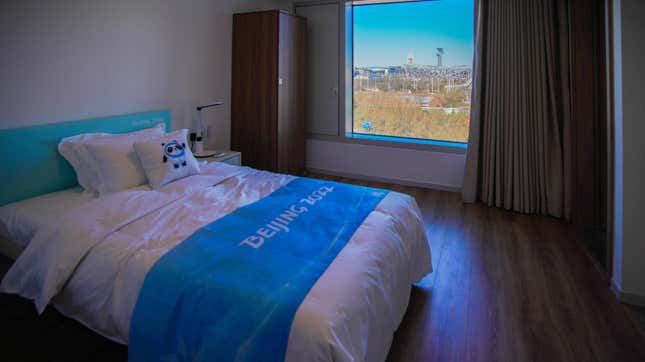
As athletes arrive in China for the Winter Olympics, one burning question has crossed more than a few minds: What will the beds be like this time? Short answer: no cardboard in sight.
U.S. luger Summer Britcher gave the internet a first look at the beds in Beijing in a recent TikTok video. Beds at the Games became an unlikely spectacle last summer during the Tokyo Olympics, which provided athletes with modest beds made of recycled cardboard frames to promote a message of sustainability. The beds went viral after some joked that they were anti-sex beds—an assumption that was later debunked—setting the stage for future scrutiny of Olympic accommodations.
In true China fashion, the beds in Beijing bear no resemblance to those in Tokyo. Far from modest, these beds are bigger and sleeker.
“Not only do we not have cardboard beds here, but it’s as if the Beijing Organizing Committee said, ‘How can we just absolutely just one up Tokyo?’” Britcher said in her video, which as of Monday has received more than 342,000 views. “And this is what they went with.”
The athlete demonstrated that the beds can be adjusted by remote control and have a zero g mode, a term I had never heard to describe a bed. According to the comments on the video, it stands for “zero gravity mode,” a setting on adjustable beds that reduces pressure on muscles and joints and helps the body fully relax.
“I’m in zero g mode now. It’s phenomenal,” Britcher said.
Wow. My back is legitimately jealous.
Olympic athletes aren’t the only ones getting treated to special beds, though. Reuters reported on Sunday that journalists were also given access to Sleep Rest Cabins, which are exactly what their name says they are, to take power naps of up to an hour. The beds in the cabins are the same ones used by the athletes in the Athletes’ Village and can be adjusted using a remote control or a phone.

The Beijing Games will feature approximately 2,900 athletes who will compete in 109 events. Tensions are high, influenced by both the pandemic and the diplomatic boycott of the event led by the U.S., which has since been joined by other countries. The boycott is a protest of China’s horrific treatment of Uyghur Muslims in the Xinjiang region and other human rights abuses in the country.
The Games open on Friday.